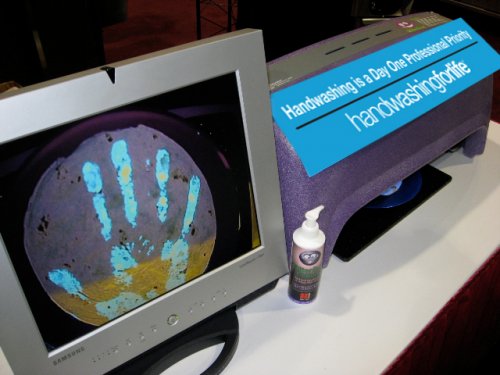At a food safety meeting in Las Vegas a few years ago, Frank Yiannis, Wal-Mart’s VP of Food Safety, recounted his 19 year stint with Disney, asking the audience “What do you remember most in your career path?”
His answer? Day one of the new job, that immersion into the new culture.
Handwashing For Life’s Day One Handwashing program leverages this reality. Entering the kitchen for the first time provides a unique opportunity to install handwashing as a job-critical priority. It is potentially a behavior-changing moment where the new employee is anxious to understand expectations and please the new boss. The Day One training personalizes and visualizes both the problem and solution.
The first day immersion into the new culture establishes basic cleanliness values as they are expressed in the actions or inactions they witness, not in what the plaque on the wall says. The new employee is an absorbent mind, perhaps at its maximum, during this first shift. The visuals of the learning experience are further intensified for those working outside their native language. Their eyes cyclonically scan every move and non-move into a pattern of truth.
If handwashing compliance is low, start this Day One program for the entire existing team. The lowest cost, most effective training is that of peer example. It both trains and untrains. Their behavior is the current expression of operational values, either fortifying or fracturing your food safety system.
“One fact well understood by observation, and well guided development, is worth a thousand times more than a thousand words”
- The American Journal of Education, 1858.
“The soul can only be engaged once the mind has a picture.”
- Aristotle
This short-form training establishes handwashing as a critical, professional priority with a minimum of management time. It is the moment for the new employee to join this caring, cleanliness culture and commit to everyday actions.
Step 1. Take a food item with a flat relatively non-porous surface. A tortilla works great. Apply GlitterBug® tracer lotion to the hand of a new employee and have him/her work it in as they would a hand lotion, covering the backs, fronts and nail beds. Press one of the invisibly soiled hands firmly onto the tortilla. Shine a UV light on both the hand and the tortilla. “There is the invisible enemy of wellness, the source of sickness and suffering.”
Step 2. Introduce the ProGrade scorecard, explaining your standards. Ask the worker to evaluate their own hands and mark the appropriate hand condition at the bottom of the template. Invite the students to wash their hands as they normally do when they are in a hurry – the Splash & Dash. Self-score the first result.
Step 3. Review the ProGrade result and discuss the jewelry and nail policies. It is also a good time to cover the ill employee policy, stressing the norovirus (fecal-hand-oral) risk to them and their families/friends. Show the first 90 seconds, the Why Wash segment, of the Handwashing For Life video.
Step 4. Take a second copy of the ProGrade, transferring the skin condition evaluation from the original. The supervisor, who will time and score this round, reapplies GlitterBug® tracer. Instruct the employee to now wash for 15-20 seconds with plenty of friction, using a nailbrush as appropriate. Dry with a single-use paper towel, also with plenty of friction. The process is repeated until either a satisfactory result is obtained or a waiver is given to cover special situations (ie. heavily callused or cracked skin).
Step 5. Celebrate success!
The new employee takes the Pledge of Professionalism, adding their name to the poster (best maintained at one of the handsinks). Place completed ProGrade form in their personnel file. Fill in Day One Training Log in preparation for sharing with auditors and inspectors.
Cover the gloving policy. Check glove size for proper fit.
Review the schedule for additional training.
Attachments:
ProGrade Scorecard
Pledge of Professionalism
Day One Training Log


